There are different capos for different types of guitar, and each capo has a different purpose depending on what you’re going to use it for. Various factors can come into play when you’re looking to choose a capo for your guitar, such as your music style, tuning and ease of use.
Different capos use different mechanisms as some use a screw while some use a spring-loaded clamp. Some capos work well depending on the guitar type, while others aren’t as efficient.
I’ve had my fair share of experience with various capos over the years. Personally, I found the G7th capos working the best for me as they provided the best ease of use, and they’re effortless to adjust when using the guitar.
In this article, I will tell you about the types of capos and how to choose one that’s best suited for you. Here are the topics we will cover in this article:
- Are There Different Kinds of Capo?
- Are Capos One Size Fits All?
- Are Cheap Capos Bad?
- Does It Matter What Capo You Buy?
6 Different Types Of Capos
Capos can have different types, sizes, shapes and purposes. They essentially serve the same function, some more effective than others.
A suitable type of capo can make a huge difference when you play your guitar. A bad capo may need constant re-adjusting, which can become distracting when you play the guitar.
All capos serve the same purpose, but the way they do this is different for each capo type as some use a clamp while come use a screw. One capo can apply pressure from both sides while the other could be distributing it on both sides.
Here is a list of the types of guitar capos.
| Price (approx.) | Ease-of-use | Adjustability | |
| Trigger | $10 | Easy | Normal |
| Screw | $15 | Normal | Hard |
| Shubb | $20 | Easy | Normal |
| Toggle | $4 | Normal | Normal |
| G7th | $50 | Easy | Easy |
| Roller | $30 | Easy | Easy |
1. Trigger Capos
Trigger capos are inexpensive, easy to adjust and an excellent capo for beginner guitarists.
These are some of the most commonly used capos, and they work by using a spring-loaded clamp to hold tension. These are some of the cheapest and most widely available capos, which is why many guitarists prefer to use them.
The design allows it to be easily repositioned with just one hand, but the tension it provides is not adjustable, which means you will face fret-buss if the tension is too weak and tuning issues if the pressure is too strong.
I recommend these capos if you’re just starting to play the guitar.
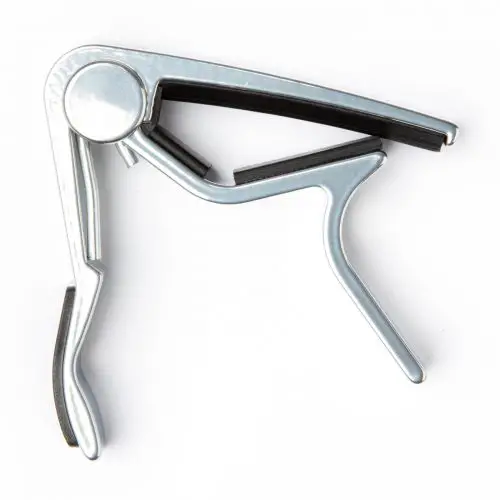
Trigger Capos are best for beginners. They are very easy to use.
2. Screw Capos
Screw capos give you far more control over the tension of the strings but take more time to set up.
These capos are similar to the trigger capos, but they use an adjustable screw than a spring-loaded mechanism. This means it takes more time to reposition the capo as you need to unscrew and re-screw it.
However, these are generally considered a better iteration of the trigger capos. They allow better control to finetune the pressure on the strings regardless of fret position, neck size or string action.
I don’t recommend this capo if you play in front of an audience as it requires more time to set up.
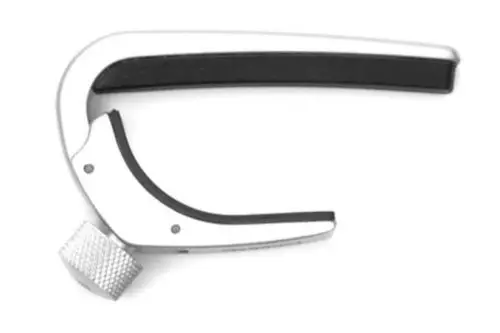
Screw Capos are great for a consistent tension and can last a long time – but requires more time to setup.
3. Shubb Capos
Shrub capos take the precision of screw capos and combine them with the ease of use of the trigger capo.
This design was created in 1980 by the company Shubb to fix the problems with other capos. It has a lever design that can be adjusted for tension and easily flipped on or off.
The innovative design of the Shrub capo combines the precision of the screw capo with the speed of the trigger capo. The rubber contact surface prevents tuning problems as it mimics the human finger.
These are more expensive than previous capos, but they’re well worth it if you play the guitar professionally.
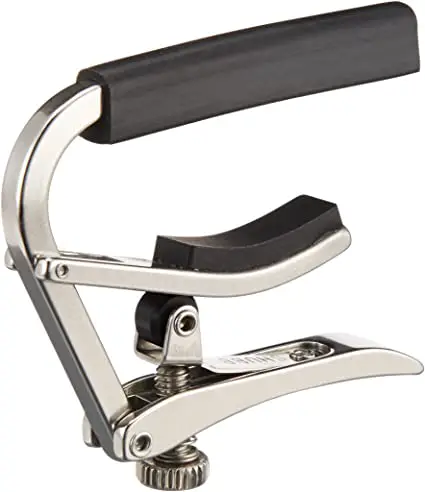
Shubb Capos are also easy to use. Great if you need the consistent tension but doesn’t like the long setup from screw capos
4. Toggle Capos
Toggle capos are lightweight capos that use adjustable straps to hold tension.
This capo features a very primitive design that holds tension using an adjustable strap. The notches can be used to tighten the capo when increased.
Guitarists prefer this because they are small and light, meaning you can take them anywhere, and you’ll barely notice them when playing. Travelling musicians prefer this one a lot.
Continuous stretching can break them, but they’re super cheap, so I recommend using these if you travel a lot with your guitar.
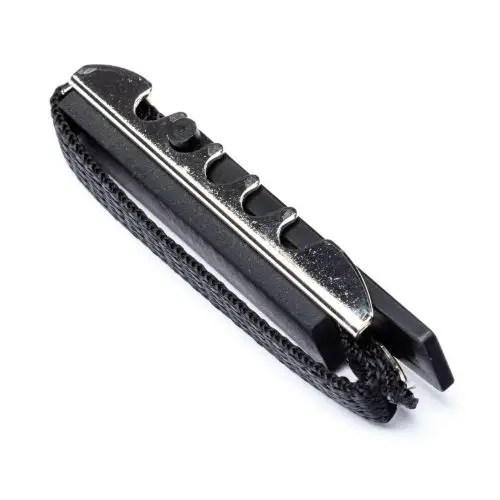
Toggle capos are best if you need a small capo to travel around
5. G7th Capos
The G7th capos are the best at preserving sound while offering the best design in the industry.
G7th capos outshined the Shubb capo offerings when they launched in 2004 as they offered considerable advancements in the capo design.
They don’t have awkward levers meaning they are unobtrusive when playing, and their rubber edges mean they’re gentle on the guitar. They lock into place, meaning they allow easy tension adjustment and are really easy to move and reposition.
These capos are almost perfect as they remove nearly all problems associated with other capo types and the G7th capos are my ultimate recommendation for guitarists.
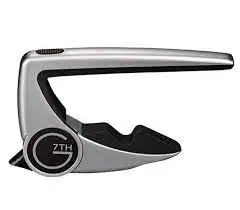
G7th capo is the best for consistency (no fret buzz). Plus, their design makes them small and very easy to use
6. Roller Capos
The roller capo features a unique design with its own sets of pros and cons.
It’s one of the least popular capo designs, but many guitars swear by it as it has fast repositioning and better pressure distribution as it applies pressure from both sides of the capo. You can also just slide it over the nut when not in use.
However, it doesn’t allow you to adjust its tension, and it can scratch your guitars. It doesn’t fit classical or 12-string guitars.
I don’t recommend this as your first capo, but you should try this design at least once to know if you like it or not.
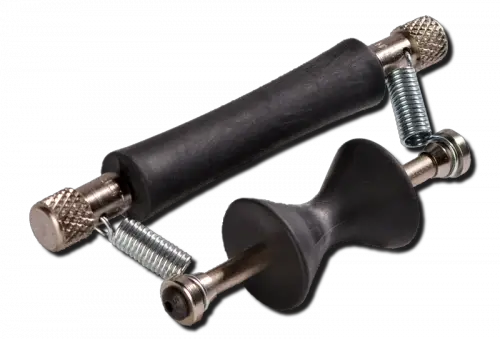
Roller capo is the capo with most unique design – where repositioning is made easy.
Are Capos One Size Fits All?
There isn’t a one-size-fits-all capo that you can fit on any guitar. Some capos are made for six-string acoustic or electric guitars, while some are made for classical ones or ones with more than six strings.
Capos generally fit all standard six-string guitars. However, some capos won’t work well with seven or more string guitars.
Some guitars have a curve in the fingerboard, so using a flat capo will only clamp down the middle strings causing fret buzz from the other strings as there will be little to no pressure on the other strings near the edge.
There are different types of capos made for different shapes and sizes of guitars. Guitar neck shapes vary at different places, making it complicated to adjust the fit of the capo. All capos have a range of thickness of the guitar neck that they can handle.
I recommend taking your guitar with you to the store when buying a capo so you can test out which capo works the best for your guitar.
Are Cheap Capos Bad?
Cheap capos sound good at first but can lose their tension and can need replacing after as little as 6 months. It’s better to just spend a little bit more on a quality capo as they’re durable and retain tension over the years.
The quality of the capo you use matters. Some think that it improves the tone, which isn’t really necessary. However, a good quality capo can enhance the sound of your guitar as it gives more even tension to the strings. Better capos are generally made of durable materials.
Capos also throw the guitars out of tune when used for extended periods, but good quality ones will do this less than simple, cheap ones. A capo only needs to hold them firmly than to clamp them down to the fretboard. This is why I would recommend getting an adjustable capo than the traditional clamp-on ones.
In the end, it matters how much you play the guitar. If guitar playing is just a hobby for you, you don’t really need to go all out on buying a guitar capo. However, if you play the guitar professionally, it’s better to purchase a good quality capo.
Does It Matter What Capo You Buy?
Most capos are designed to be used universally, so you generally don’t have to go for a specific capo. However, if you like a particular brand, it’s likely that they offer several options for different guitars so you can find one that fits your guitar perfectly.
Quality-wise I always recommend getting one that works with your guitar well and has soft material that won’t damage your guitar’s body. Good quality capos can last you a couple of years, so you can just buy one and forget about it for at least 3 years.
Conclusion
Your choice of a capo for your guitar depends on your end goal. Whether you’re playing the guitar alone as a hobby or in front of a crowd as a professional, you need to keep in mind the convenience and speed the capo allows you.
No matter what you do, remember to always go to a store and try on the capos before you buy them to ensure you get one that has the perfect fit on your guitar.





